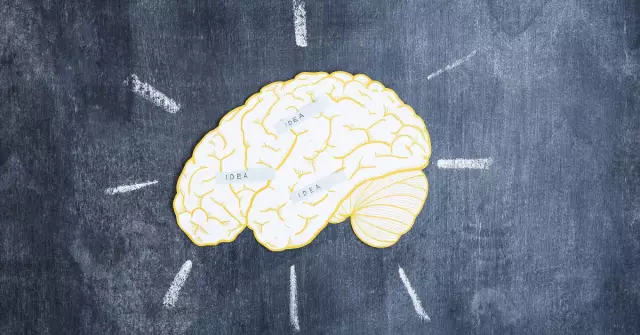- Author Rachel Wainwright [email protected].
- Public 2023-12-15 07:39.
- Last modified 2025-11-02 20:14.
Arnold-Chiari anomaly
Arnold-Chiari anomaly is a congenital defect in the development of the rhomboid brain. This anomaly is manifested by a discrepancy between the size of the posterior cranial region and the brain components located in it. As a result, this leads to the fact that part of the tonsils of the cerebellum and brain descend into the foramen magnum, where they are pinched.
The reasons for the development of the Arnold-Chiari anomaly
According to statistics, this pathology is observed in 3-8 people out of every 100 thousand.
To date, the exact cause of the development of Chiari malformation has not been identified. Most likely, the manifestation of this disease is accompanied by the following three factors:
- traumatic injury to the wedge-occipital and wedge-ethmoid part of the clivus as a result of birth trauma;
- congenital osteoneuropathies with a hereditary factor;
- hydrodynamic shock of cerebrospinal fluid into the walls of the central canal of the spinal cord.
What anatomical changes occur with Arnold-Chiari malformation?
With this pathology, the cerebellum is located in the posterior cranial fossa.
Normally, the lower part of the cerebellum (tonsils) should be located above the foramen magnum. In Arnold-Chiari anomalies, the tonsils are located in the spinal canal, that is, under the foramen magnum.
The foramen magnum serves as a kind of border between the spine and the skull, as well as between the spinal cord and the brain. Above this opening is the posterior cranial fossa, and below it is the spinal canal.
The lower part of the brain stem (medulla oblongata) passes into the spinal cord at the level of the foramen magnum. Normally, the cerebrospinal fluid (cerebrospinal fluid) should circulate freely in the subarachnoid spaces of the spinal cord and brain. These subarachnoid spaces are interconnected at the level of the foramen magnum, which ensures a free outflow of cerebrospinal fluid from the brain.
In Arnold-Chiari malformation, the tonsils are located under the foramen magnum, which makes it difficult for the free flow of cerebrospinal fluid between the brain and spinal cord. The cerebellar tonsils block the foramen magnum like a plug, which significantly disrupts the outflow of cerebrospinal fluid and leads to the development of hydrocephalus.
Arnold-Chiari anomaly types
In 1891 Chiari identified four main types of pathology and described each in detail. Doctors use this classification to this day.
- 1 type. It is characterized by the omission of the structures of the posterior cranial fossa below the plane of the foramen magnum.
- Type 2, which is characterized by the caudal dislocation of the lower parts of the skull, 4th ventricle and medulla oblongata. This is often accompanied by hydrocephalus.
- Type 3. This type of disease is quite rare and is characterized by a gross caudal displacement of all structures of the posterior cranial fossa.
- Type 4, when hypoplasia of the cerebellum occurs without its displacement downward.
The third and fourth types of Arnold-Chiari malformation do not respond to treatment and are usually fatal.
In the vast majority of patients (about 80%), the Arnold-Chiari anomaly is combined with syringomyelia - a pathology of the spinal cord, which is characterized by the formation of cysts in it, contributing to the development of progressive myelopathy. Similar cysts are formed when the structures of the posterior cranial fossa descend and as a result of compression of the cervical spinal cord.
Arnold-Chiari malformation symptoms

This pathology is characterized by the following clinical signs:
- loss of temperature and pain sensitivity of the upper limbs;
- pain in the cervico-occipital region, aggravated by sneezing and coughing;
- loss of visual acuity;
- loss of muscle strength in the upper limbs;
- frequent dizziness, fainting;
- spasticity of the lower and upper limbs.
In more advanced stages of the disease, the symptoms of the Arnold-Chiari malformation are accompanied by a weakening of the pharyngeal reflex, episodes of apnea (temporary stops in breathing) and involuntary rapid eye movements.
This disease is fraught with the development of the following complications:
- Paralysis of the nerves of the skull, infringement of the cervical spinal cord, dysfunction of the cerebellum, occurring against the background of progressive signs of intracranial hypertension.
- It happens that this pathology is associated with skeletal defects: occipitalization of the atlas or basilar impression (funnel-shaped depression of the craniospinal articulation and clivus).
- Deformities of the feet, anomalies of the spine.
Sometimes the Arnold-Chiari malformation is asymptomatic and is detected only during a general examination of the patient.
Diagnostics of the Arnold-Chiari anomaly
The main method for diagnosing this disease today is MRI of the thoracic and cervical spinal cord and MRI of the brain. MRI of the spinal cord is done primarily to detect syringomyelia.
Arnold-Chiari malformation treatment
If the disease has only one symptom - pain in the neck, then the treatment of the Arnold-Chiari malformation is mostly conservative. Therapy includes various regimens using muscle relaxants and non-steroidal anti-inflammatory drugs.
If the effect of conservative treatment is insufficient or absent altogether for 2-3 months of treatment, as well as if the patient has symptoms of neurological failure (weakness and numbness of the limbs, etc.), then the doctor, as a rule, suggests an operation for Arnold-Chiari anomaly …
The main purpose of the operation for Arnold-Chiari anomaly is to minimize the infringement of nerve endings and tissues and normalize the outflow of cerebrospinal fluid, for which the size of the posterior cranial fossa is slightly increased in volume. As a result of the operation, with the Arnold-Chiari anomaly, the headache completely disappears or decreases, the motor functions and sensitivity of the limbs are partially restored.
The information is generalized and provided for informational purposes only. At the first sign of illness, see your doctor. Self-medication is hazardous to health!






